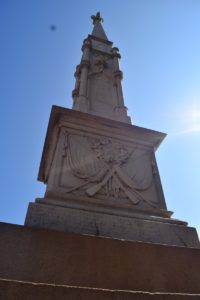Are Confederate Monuments being taken for Granite?
Even if you didn’t know Athens had a Confederate monument, chances are you’ve seen it standing just thirty odd feet away from the University of Georgia Arch on Broad Street, located directly in the median and standing among the trees and two other monuments downtown.
Confederate statues, and their place, have been debated for years but until the more recent national movement to remove them, they were, for the most part, out of the public eyes. Many groups want the monuments to be destroyed or removed as they view them as symbols of oppression, slavery and America’s racist history, while others argue that the statues are a source of pride and stand as symbols against tyranny.
In Athens, this debate sprouted up weeks before the Charlottesville Protests as a public discussion, but after the protests the debate became much more heated. It raises the question for us as Athenians: what do we do with our Confederate monument — a grey stone obelisk built in 1871?
 Athens’ monument is older than most Confederate statues, built in 1871 in the height of reconstruction. Statutes of General Lee or President Davis have been erected across the South, but they were often built during periods of civil unrest and poor efforts to foster race relations after the war. Most of these statues were built during the 1890s and 1910s when race riots were common, and they were later refurbished during the 1950s and 60s when desegregation was an issue in the South.
Athens’ monument is older than most Confederate statues, built in 1871 in the height of reconstruction. Statutes of General Lee or President Davis have been erected across the South, but they were often built during periods of civil unrest and poor efforts to foster race relations after the war. Most of these statues were built during the 1890s and 1910s when race riots were common, and they were later refurbished during the 1950s and 60s when desegregation was an issue in the South.
The monument is not only older, but also built by a temperance organization, the Athens’ Ladies Memorial Association, and not actual Klansmen or white supremacists. The Athens’ Ladies Memorial Association was dedicated, like other southern Ladies Memorial Associations, to the “Lost Cause of the Confederacy”. In general the Ladies Memorial Associations, widespread across the south, once served as the pillar of society for upper class white women. These associations became defunct around the turn of the 19th century, as members followed trends and flocked to join the United Daughters of the Confederacy.
The monument isn’t a symbol for the wealthy former slave owners. Instead, the Athens’ Ladies Memorial Association built it to honor ordinary folk who fought for multiple issues including slavery. 200 names of fallen soldiers are inscribed on the monochrome monolith.
Athens’ monument is unlike those that started the unrest in Charlottesville, or those that were removed from New Orleans. It’s not a statue of a person. This monument bears no likeness of Nathan Bedford Forrest, a Confederate General and Klansman; or Robert E. Lee, a Confederate General and slave owner; or that of Confederate President Jefferson Davis.
The monument has its share of history, being a symbol of pride during the early 1900s for white supremacists and in the fifties and sixties for segregationists.
For years the obelisk downtown was adorned with small Confederate flags at its base, the national flag of the Confederacy, also known as the stars and bars, the Bonnie Blue Flag, and the now infamous Confederate Battle Flag. These flags, no bigger than one’s palm, were removed from the monument over a decade ago.
The question of what to do with the monument amplified after the Charlottesville protest when an Athens-based town hall discussion was held on both issues. On August 17, more than 300 citizens gathered at the Athens-Clarke County Library, and more recently the conversation was renewed on October 2, again at the public library, hosted by the Athens’ Anti-Discrimination Movement. This meeting hosted less than two dozen visitors. The majority of the room held a consensus view, to move the monument to the Oconee Hill Cemetery, with only a single person vocally opposing this idea.
So Athens is left with three options over its Confederate monument: removing it, relocating it, or letting it remain where it is.
Removal is the most extreme plan, taking the monument, and possibly destroying it like a toppled statue of Saddam Hussein. Removing the monument means that it won’t be moved to a new site unless it’s a garbage dump. This is the least popular plan for the monument and had little vocal support in Athens, but is a more popular option for statues across the South.
In New Orleans, Mayor Mitch Landrieu removed a statue of Robert E. Lee from a public square named in his honor; an American flag replaced the statue. Lee himself was against the very idea of Confederate statues. In a letter to a fellow former Confederate General, he wrote, “I think it wiser not to keep open the sores of war but to follow the examples of those nations who endeavored to obliterate the marks of civil strife, to commit to oblivion the feelings engendered.”
Relocating is the middle ground, preserving the monument away from the epicenter of downtown Athens. The monument would be moved to the Oconee Hill Cemetery in the shadow of Sanford Stadium that’s already occupied by a similar Confederate memorial. Unlike the one downtown, however, this memorial has spent its entire existence in the Oconee Hill Cemetery.
There are two big problem with this plan: will Athens’ oldest cemetery will take the obelisk, and what are the legal issues of moving a Confederate monument? The state of Georgia bans the removal or relocation of Confederate statues unless it is a threat to safety, which many Athenians argue it is seeing how it needed repairs back in 2014. Others have suggested that the monument should be moved to a museum to serve as a piece of history yet no plans have been suggested.
The argument to let the monument remain is the status quo argument, suggesting that the monument should stay downtown where it has been for the last 146 years. Many arguing this point say that the double barrel cannon at City Hall is another Confederate monument.
Although some see it as a humorous symbol of failure, the double barrel cannon sits at the footsteps of City Hall, pointed, like many others, belligerently towards the north. Athens’ monument, like the cannon now, was used to decorate postcards for Athens and was a symbol of pride. Others even argue that the monument should stay where it is and let sleeping dogs lie, leaving the argument blunt and simple.
Regardless of one’s opinion on the monument, current debate elevates the monument to become more than what it was originally made to represent. It stands in the middle of a heated debate, but many forget the simple truth of the argument. The monument is nothing more than a piece of rock to those who don’t know its story, and these conversations have stirred up history that may have been otherwise forgotten.




